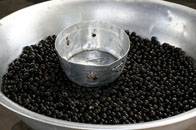By Emma Suttie, D.Ac.
It is a terrible thing to admit, but I, an acupuncturist, hate needles.
Whenever I have to go to the doctor to have blood taken, I surprise even myself with the creative ways I manage to not make it
down to the nurse to have my blood drawn. My doctor knows this about me, and I am always
getting the sass.
The truth is, having blood taken hurts (it hurts me anyways). The
needles they use are hollow point, and it usually takes them a
few tries before they can get a vein. I am always left with bruises,
and this is why I don’t like needles.
Acupuncture needles however, are not like the hollow point needles
used to take blood or give injections. They are very fine – 4 times
thicker than a human hair in fact (the thickness varies, but they
are pretty small), and in most cases, the patient can barely feel them.
They are also disposable, and one
use only.
I have often had patients over the years who reluctantly came to see
me, not committing to a treatment, but wanting to talk about their fear
of needles. I always say “no problem, have a seat.” I explain that the
needles that acupuncturists use are not the type used by medical
doctors, and that they are tiny in comparison. I take out one out, open
it and hand it to them so they can feel it, touch it, and this helps
with the fear. I then roll up my sleeve and tap the needle gently into
my arm to show them how it works, and that I am not screaming in pain. I
explain that I am very gentle, and if
they would like to try, I can put a needle into the same spot on their
arm. I tell them if they feel
anything uncomfortable or painful for even an instant, then it comes
out.
I have never had anyone after the demonstration, not try one needle.
Once they see that acupuncture is not painful, we continue with an
intake, and then a treatment. People often have to ask me when I will be
putting the needles in when I
already have put in several.
Here is a chart that illustrates the difference in size between different objects and
an acupuncture needle.

In my experience, there is a difference in the old school Chinese
style of acupuncture which emphasizes strong stimulation of the needles
(twirling and twisting the needles to achieve a "qi sensation"), and a
gentler style that is better suited to Western
patients. When in China, I got to visit a hospital that offered both
Western and Chinese medicine and saw
some of the acupuncture techniques used. They were a lot more hard core
than most patients are used to
here in the West. In China, this is what is expected, but if you are
catering to Western patients, gentler
and kinder is the way to go. It is relatively new here, so it should be
introduced gently to those who are
trying it out, and especially those who are a bit nervous about needles.
As a kid I went to a Chinese acupuncturist who was incredibly gentle.
I never felt any pain from the needles, and I have always fashioned
myself after her. There is an intimate trust relationship between an
acupuncturist and their patient. They must trust you, and their body
must trust you, which you can feel when you are putting in the needles.
At first there is often resistance which decreases as time goes
on. Eventually, the body accepts the treatment and trusts that you are
doing it
good and mean it no harm.
So, if you are curious about acupuncture but haven’t gone to have a
treatment because of a fear of needles, I would say find an
acupuncturist and go and speak to them. Most are aware that fear of
needles is common and will do their best to explain and show you so
that you can start to reap the wonderful rewards offered by acupuncture.
I know I am very glad that I did.
About the Author:
Emma’s love for Chinese Medicine began as a teenager when, like many
people, western medicine failed to solve the underlying health issues she
faced. Her doctors proposed only surgery or a lifetime of drugs. However,
after a few months of acupuncture treatments and herbs those problems were
resolved. From that moment forward she was committed to extending this gift
of health to others.
Emma received a Diploma of Acupuncture from the Institute of Traditional
Medicine in Toronto in 2006. Immediately after graduating, she started her
first job treating postal workers and seeing up to 20 patients a day! Over
the next several years she worked at 5 other multidisciplinary clinics
throughout Toronto developing her skills and technique while working
collaboratively with other health professionals, including medical doctors,
to restore health to her patients holistically.
Today she specializes in gynecology, pediatrics and treating emotional
issues and mood disorders through her own practice,
Ukiah Clinic. She also shares her experience and
enthusiasm on her new website,
Chinese Medicine Living
that explores ancient Chinese
wisdom for better living in the modern world.
http://www.acupuncture.com/newsletters/m_apr13/needles.htm
 by Chris and Sheree Geo
by Chris and Sheree Geo




